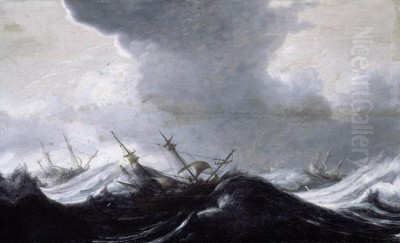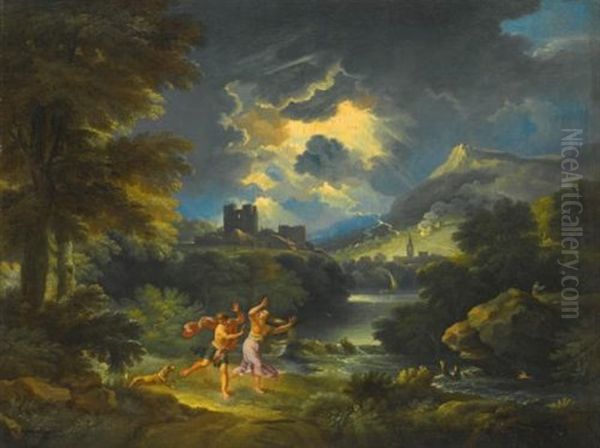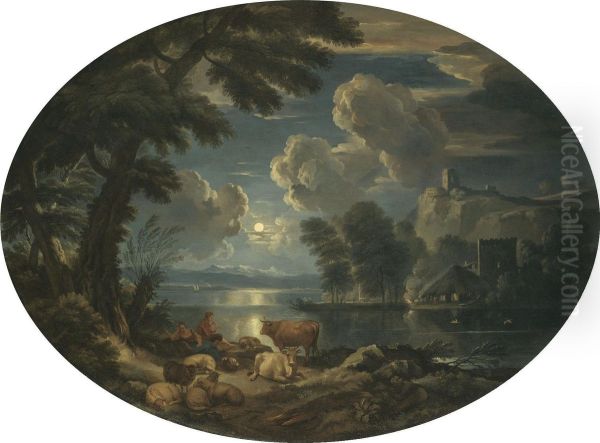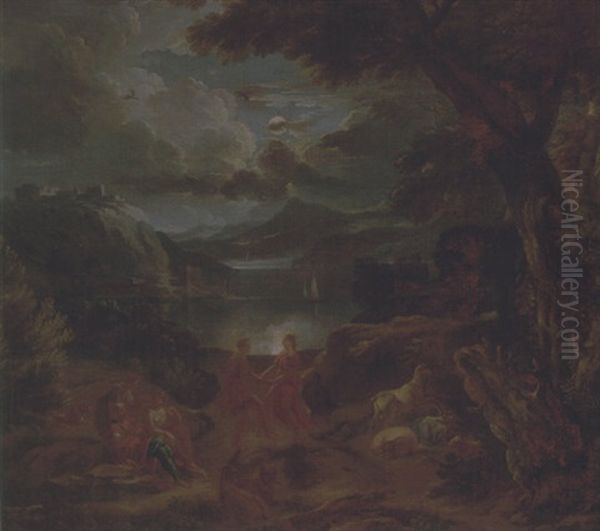
Pieter Mulier the Younger, often known by his evocative nickname "Il Tempesta" (The Storm), stands as a fascinating figure in the landscape of Dutch Golden Age painting. Born around 1637 in Haarlem, Netherlands, and passing away in Milan, Italy, in 1701, his life and art bridged the distinct artistic traditions of Northern Europe and the Italian peninsula. He specialized in landscape and marine paintings, becoming particularly renowned for his dramatic depictions of storms at sea and atmospheric pastoral scenes, earning him both acclaim and a degree of notoriety during his turbulent life.
Mulier's journey from the Netherlands to becoming a celebrated, albeit controversial, figure in Italy reflects the broader trend of Dutch artists seeking inspiration and patronage south of the Alps. His work uniquely blends the detailed realism characteristic of Dutch art with the grandeur, dramatic lighting, and classical influences of the Italian Baroque, securing him a distinct place in art history.
Early Life and Dutch Foundations
Born into an artistic family in Haarlem, a major center for Dutch painting, Pieter Mulier the Younger was inevitably exposed to art from a young age. His father, Pieter Mulier the Elder (c. 1615–1670), was himself a recognized painter, specializing primarily in marine subjects – ships and seascapes rendered in the prevailing Dutch realist style. This paternal influence undoubtedly provided the younger Mulier with his initial training and grounding in the techniques of oil painting and the specific genre of marine art.
Haarlem during the mid-17th century was a vibrant artistic hub. Painters like Jacob van Ruisdael, the preeminent landscape painter of the era, and Philips Wouwerman, known for his scenes with horses and battles, were active there. While direct tutelage under these masters isn't documented, Mulier would have been immersed in an environment where landscape and genre painting flourished, emphasizing atmospheric effects, detailed observation of nature, and skillful composition. He joined the Haarlem Guild of Saint Luke around 1656, a standard step for professional artists, indicating he had achieved a recognized level of competence before embarking on his transformative journey southward.
The Italian Transformation: Rome and Beyond

Around the time of his Guild entry or shortly thereafter, Mulier traveled to Italy, a move that would profoundly shape his artistic identity. He settled in Rome, the magnetic center of the European art world, which drew artists from across the continent. The city offered exposure to classical antiquities, Renaissance masterpieces, and the dynamic developments of the Baroque style. For a landscape painter, the Roman Campagna – the surrounding countryside – with its ancient ruins, rolling hills, and distinctive light, was an endless source of inspiration.
In Rome, Mulier absorbed the influences of leading landscape painters. The idealized, light-filled classical landscapes of the French expatriate Claude Lorrain, who had long worked in Rome, offered a model of harmonious composition and atmospheric perspective. Equally significant was the influence of Gaspard Dughet (also known as Gaspard Poussin), brother-in-law of Nicolas Poussin and a master of depicting the wilder, more dramatic aspects of the Roman Campagna. Mulier is known to have collaborated directly with Dughet.
This collaboration included working on frescoes for the Palazzo Colonna, one of Rome's most prominent noble residences. Such large-scale decorative projects, often integrated with architecture, were characteristic of the Baroque era and provided artists like Mulier with opportunities for prestigious commissions and the development of a grander, more decorative style than typically found in Dutch cabinet paintings. His work during this Roman period (lasting until the late 1660s or early 1670s) saw him increasingly adopt Italianate motifs and a more dramatic handling of light and composition, moving away from the purely Dutch style of his father. Other Dutch artists working in Italy around this time, known as the "Italianates," included Jan Both and Nicolaes Berchem, who similarly blended Dutch technique with Italian scenery and light.
Il Tempesta: Style, Subject, and Nickname
It was during his Italian years that Pieter Mulier the Younger likely acquired the nickname "Il Tempesta." This moniker perfectly captured his growing reputation for painting dramatic storms, particularly at sea, but also tumultuous weather in landscapes. These works were characterized by dark, churning clouds, wind-lashed trees or waves, dramatic contrasts of light and shadow, and often small figures battling the elements, emphasizing the power and sublimity of nature. This focus aligned him with the more dramatic landscape traditions, perhaps influenced by the Neapolitan painter Salvator Rosa, known for his rugged, wild scenes.

However, Mulier's oeuvre was not limited to tempests. He also excelled at painting tranquil pastoral landscapes, often bathed in the warm, golden light associated with Claude Lorrain and the Italian Campagna. These scenes frequently feature shepherds, flocks, classical ruins, and serene bodies of water, rendered with a delicate touch and atmospheric depth. His ability to capture diverse moods of nature, from violent storms to idyllic calm, showcased his versatility.
His style synthesized his Dutch heritage – evident in the meticulous rendering of details, textures, and atmospheric perspective – with Italian influences. These included the use of classical compositional structures, idealized landscape elements, and the dramatic chiaroscuro (light-dark contrast) characteristic of the Baroque. He developed a fluid brushwork and a rich color palette, capable of conveying both the turbulence of a storm and the tranquility of a sunlit afternoon. His compositions were noted for their skillful perspective and harmonious arrangement, even within dynamic scenes.
Genoa, Imprisonment, and Controversy
After his successful period in Rome, Mulier moved north, spending significant time in Genoa from the early 1670s. Genoa was a wealthy maritime republic and an important artistic center. Here, Mulier continued to paint, finding patrons among the Genoese aristocracy. However, his time in Genoa was marked by a dark and dramatic turn of events that has become inextricably linked with his biography.
In 1676, Mulier was arrested and imprisoned on suspicion of having arranged the murder of his first wife. Accounts suggest a complex situation involving his desire to marry another woman, Anna Eleonora Beltrami. Despite the serious charges, Mulier was never definitively convicted, but he spent a considerable period incarcerated – sources suggest until around 1684. Remarkably, his artistic production did not cease during his imprisonment. He was apparently allowed painting materials and continued to create works, some possibly even commissioned by patrons aware of his situation. This period adds a layer of intrigue and darkness to the artist often associated with the dramatic forces of nature in his paintings.
Later Career: Venice and Milan
Following his release from prison in Genoa, Mulier's career continued, demonstrating his resilience and the enduring demand for his work. He is documented as working in Venice, another major artistic hub, known for its distinctive light and colorito tradition, exemplified by masters like Titian and Tintoretto centuries earlier. While his Venetian period is less documented than his time in Rome or Genoa, the city's atmosphere likely offered new inspiration for his atmospheric landscapes and seascapes.

His final years were spent in Milan, where he settled around 1684 and remained until his death in 1701. He continued to be productive, and his reputation remained high. It was likely during this later period, possibly through the influence of patrons like the Duke of Bracciano, Flavio Orsini (though the exact timing is debated), that he received a knighthood, leading to the title "Cavalier Tempesta." This honorific acknowledged his artistic status. In Milan, his style may have influenced local artists, including the later painter Alessandro Magnasco, known for his own dramatic and atmospheric scenes.
Throughout his later career, Mulier maintained his characteristic blend of Dutch detail and Italianate grandeur. His mature works often display a confident handling of paint, sophisticated compositions, and a masterful control over light and atmosphere, whether depicting serene harbors or raging storms. Despite the personal turmoil he experienced, his artistic output remained significant and sought after.
Representative Works
While attributing specific works definitively can sometimes be challenging due to workshop practices and imitators, several paintings are considered representative of Pieter Mulier the Younger's style and subject matter:
_Landscape with Figures in a Storm_: This title, or variations like _Seascape in a Storm_, represents a core theme. Such works typically depict ships struggling against high waves under dark, dramatic skies, often illuminated by flashes of lightning. They showcase his ability to convey movement, atmosphere, and the power of nature, combining Dutch maritime traditions with Baroque drama. Examples exist in various collections, highlighting his fame for this genre.
_A Moonlit Scene With A Shepherdess And Shepherd Resting Their Herd Beside A Lake_: This work exemplifies his skill in capturing tranquil, atmospheric nocturnal or crepuscular scenes. The soft moonlight, reflections on water, and peacefully resting figures create a poetic, idyllic mood, contrasting sharply with his storm paintings. It reflects the influence of Claude Lorrain's idealized pastoral landscapes.
_Landscape with Waterfall and Figures_: Often painted on a large scale, these works demonstrate his ability to construct complex, grand landscapes. Featuring elements like cascading water, rocky outcrops, lush foliage, and small figures (sometimes mythological or biblical, sometimes pastoral), they combine detailed observation with an idealized composition, typical of the Italianate landscape tradition.
_Italianate Landscapes with Ruins and Pastoral Figures_: Many of Mulier's works fit this description, featuring the characteristic elements sought by patrons who admired Italian scenery – ancient ruins hinting at a glorious past, shepherds and their flocks symbolizing Arcadian peace, all bathed in the warm light of the Italian sun. These works solidified his reputation as a master of the Italianate style.
_Frescoes in the Palazzo Colonna (Rome)_: Although frescoes are immovable and part of a larger decorative scheme, his contribution (in collaboration with Gaspard Dughet) to this prestigious project is a significant part of his oeuvre, demonstrating his ability to work on a monumental scale within the high Baroque context of Roman palaces.
Contemporaries and Influence
Pieter Mulier the Younger operated within a rich artistic landscape. His contemporaries included some of the greatest names of the Dutch Golden Age, such as:
1. Rembrandt van Rijn (1606-1669): The towering figure of Dutch art, known for portraits, history paintings, and etchings.
2. Johannes Vermeer (1632-1675): Master of intimate interior scenes, celebrated for his handling of light.
3. Jacob van Ruisdael (c. 1628-1682): The leading Dutch landscape painter of the period, known for his naturalistic and often melancholic views.
4. Meindert Hobbema (1638-1709): Ruisdael's pupil, famous for his wooded landscapes.
5. Aelbert Cuyp (1620-1691): Known for his idyllic landscapes bathed in golden light, often featuring cattle.
6. Paulus Potter (1625-1654): Renowned for his paintings of animals, particularly cattle, in landscape settings.
7. Jan van Goyen (1596-1656): An earlier landscape painter known for his tonal, atmospheric style.
8. Philips Wouwerman (1619-1668): Haarlem contemporary known for scenes with horses.
In Italy, his key influences and contemporaries included:
9. Claude Lorrain (1600-1682): The French master of idealized, classical landscapes working in Rome.
10. Gaspard Dughet (1615-1675): French/Italian painter of the Roman Campagna, collaborator with Mulier.
11. Salvator Rosa (1615-1673): Neapolitan painter known for his wild, romantic landscapes and battle scenes.
Other Dutch Italianates active during or overlapping with Mulier's time include:
12. Jan Both (c. 1618-1652)
13. Nicolaes Berchem (1620-1683)
14. Jan Asselijn (c. 1610-1652)
Mulier also had pupils, most notably Carlo Antonio Tavella (1668–1738), an Italian painter who became known for his landscapes, carrying forward aspects of Mulier's style. His work also influenced later landscape painters who admired his dramatic effects and atmospheric rendering, such as Alessandro Magnasco (1667-1749) in Genoa and Milan. His paintings, particularly the storm scenes, contributed to the developing taste for the sublime and picturesque in landscape art that would flourish later in the 18th century.
Legacy and Art Historical Assessment
Pieter Mulier the Younger occupies a significant position as a key figure among the Dutch Italianate painters. His ability to successfully merge the meticulous realism and atmospheric sensitivity of his native tradition with the grandeur, drama, and idealized beauty of Italian Baroque landscape painting set him apart. His nickname, "Il Tempesta," attests to his mastery in depicting the power of nature, a theme that resonated with Baroque sensibilities and anticipated later Romantic preoccupations.
His works were highly valued during his lifetime, sought after by prominent patrons in Italy. Despite the shadow cast by his imprisonment, his artistic reputation endured. While his fame may have waned somewhat in the centuries immediately following his death, overshadowed perhaps by artists like Claude Lorrain or Jacob van Ruisdael, the 20th century saw a renewed appreciation for the Dutch Italianates and for Mulier's specific contributions.
Art historians today recognize him as a versatile and technically skilled painter who played an important role in the cross-cultural artistic exchanges between the Netherlands and Italy. His dramatic seascapes remain powerful examples of marine painting, while his pastoral scenes offer compelling visions of an idealized Italian countryside. His life story, marked by both artistic success and personal turmoil, adds a layer of human drama to his legacy as "Cavalier Tempesta," the master of storms.
Conclusion
Pieter Mulier the Younger, Il Tempesta, remains a compelling artist whose life journey mirrored the geographical and stylistic range of his art. From his beginnings in Haarlem, grounded in the Dutch tradition, he embraced the light, landscape, and drama of Italy, forging a unique and influential style. His mastery in capturing both the fury of storms and the serenity of pastoral life, combined with his skillful blending of Northern detail and Southern grandeur, ensures his enduring place in the history of European landscape painting. His works continue to engage viewers with their atmospheric power and technical brilliance, reflecting the turbulent beauty he found in nature and, perhaps, in life itself.